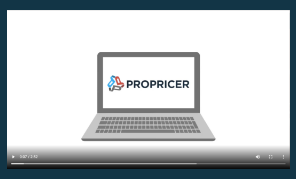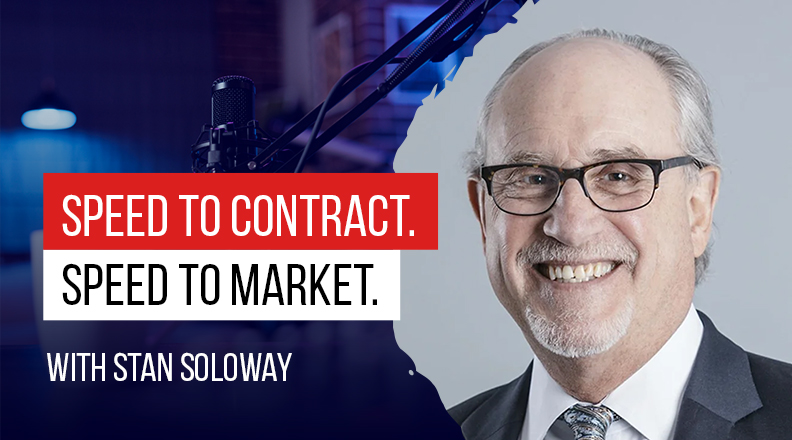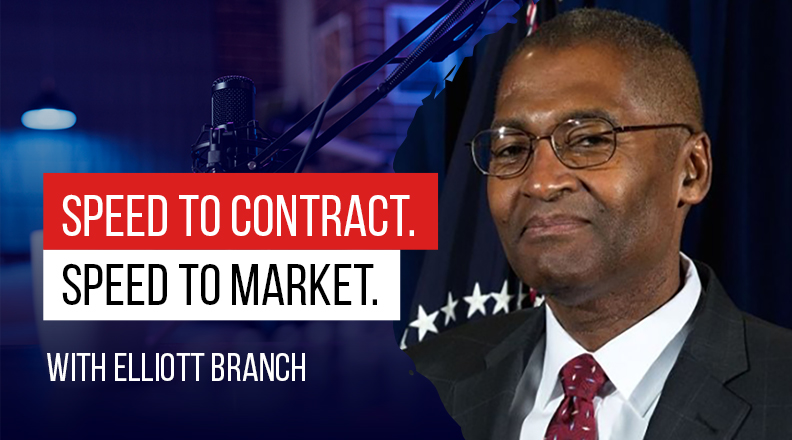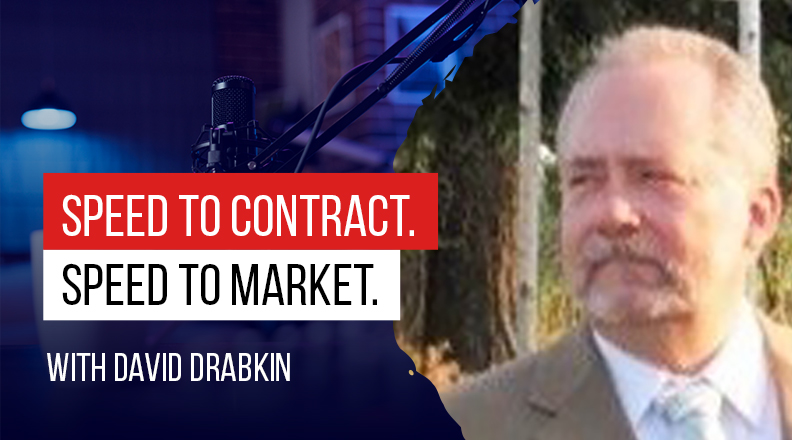Imagine a symbiosis between commercial and government acquisition practices. In these excerpts from our Speed to Contract, Speed to Market video podcast episode featuring David Cade, VP of US Government Business Services Transformation at Boeing Co., host Tim Templeton learns about the power of forming templated contracts, standardizing proposal procedures, and creating a mutually beneficial relationship between entrepreneurial and agency approaches.
We’ve edited these comments for brevity and clarity.
I always joke, “You have problems when you involve the lawyers.”
What tends to happen in government contracting is basic game theory. I have an Economics and Political Science degree from Penn. And really, I focused on strategy and game theory.
If you break contracting down to its most basic levels: When you're only going to see a person (client or supplier) once, the incentive to take advantage of them is very high. But as you recognize you're going to have more and more interaction, it's always like, “Well, I can't do anything to take advantage of them this time because I'm going to see them tomorrow and tomorrow and tomorrow.” And that's really the contracting realm; it’s building around trust and recognizing you will see that person again.
Contracts take up redundant resources & timeframes
When I started with Boeing in 2008, my internal client was Supplier Management. And eventually, I went onto the business side and actually worked in Supplier Management. One of the things we discussed was all the transactions that were occurring with our suppliers. It was the same set of negotiations with a supplier, but the contracts were all unique, and each depended on who was involved.
And so, at Boeing, each person had a particular proclivity and wanted their contract a certain way in terms of dealing with a supplier. You could have the exact same procurement two months later with a different person. And there were various things emphasized in each contract. And so, you never had any one contract “look” in common. It required a lot of personnel. And it also required reading a contract and going through all its details to understand if there was a dispute in what was happening.
Forming templated or patterned contracts
One of the first things we did? We formed patterned or templated contracts. Right off the bat, we recognized that our suppliers were going to see us and each other again, and we would keep having a negotiation. Unless you standardize your contract, it's a lot of mental energy wasted on the same issue repeatedly.
Supplier negotiations? Present the 90% you agree on before the 10% you don't
I won't name the supplier, but they were the first one out of the chute: They came in, did a bunch of machinations, and were upset about our standard contract Terms and Conditions; there were all these objections. And I said, "I'm so glad you raised them." I had a PowerPoint, pulled up their standard Terms and Conditions, and then showed both documents, which I cross-referenced. I cut and pasted to see where they had limitational liability, and choice of law. You name it.
I had it all there. And then, I crossed out the different extraneous words in each so we could see that our contracts were about 90% similar. I said, “Okay, do we want to argue and discuss the 10%, or do we want to start from the beginning and argue over all of it?”
That set the tone. The supplier said, “Okay, we get it.” I said, “Your issue is not with my Terms and Conditions as much as with the 10% that we can agree to disagree on, and you're just not used to what I have or how I have it presented. And because of the change—and change is difficult—you're automatically throwing up an objection. Instead, let’s take a step back and see where we agree, and then see where we disagree and really where we can move the needle.”
Patterned agreements require fewer people & are easier to understand
We went through a series of meetings with all our major suppliers, where we had these patterned agreements, and we only sometimes got everything we wanted. They only sometimes got everything they wanted. But we standardized it so you could utilize fewer people to manage a contract. It made it a lot easier to know what was in the contract. Because it was a standard we were considering rather than a differentiation each time. And the focus came to be on price and delivery dates—the stuff that mattered to the ultimate customer, the warfighter.
Proposals should standardize for speed to contract
So that was a step function that pushed the supplier-management function forward. The flip side is that we need to do that more with our government customers. And when we talk about speed to contract, it's the same issue.
You can buy the same part or sell the same part. And Contracting Officers rotate; we ourselves rotate internally. It depends on the volume. It depends on who might be the Program Officer or where the functional direction is coming from in government. It could be things such as “What is the use of the product?” If it's an F-18 and it's in theater, there will be a lot more attention paid to it versus when it’s not running. Or maybe we're doing depo work, and we're upgrading.
So that's the first place we need to look. How do we get past issues that use up so much mental energy and become emotional for people?
At the end of the day, it's like a tug of war, but you end up in the same place most of the time. If we recognize that right off the bat, we could avoid many of these problems and focus on the critical questions: “What is the delivery date? What is the price? What are things we can tweak to get a better price?” Or if it's either a long-term or a more significant quantity buy. Or if it’s seasonal. For instance, if they're buying on the sustainment side—wheels, tires, and brakes. But we don't end up focusing on that. We concentrate on liability limitation and all else.
Case study: Isolating the ‘10% issues’ with a foreign government
I won't name the foreign government, but we had a similar situation with one. Our customer found additional funding. They wanted to buy products. And the financials were off in the business unit I was supporting. So, we're like, “Hey, this will obviously help us increase sales.” So they send three of us over to negotiate. And before we went, I called the insurance guys and others and asked, “What are the issues we've always fought?” And they had two issues, but one was paramount, which was a limitation of liability. So, we go into this meeting, and they've got senior staff, government staff there from their military.
And I said, “Before we can get started, this is going to be the issue: We fight about all this stuff, and it’s noise. We can simplify it. We will fight over this one issue, and here will be the problem: I can't sell you this product without a limitation of liability. You don't want to grant it to me, but this must go through for a foreign military sale. You don't have an agreement with the government or the US government, so technically, you can't even buy certain parts. So, I'm not even selling you a full product. I'm selling you a bag of parts.” And then I said, “Just think about it, you go to a toy store for your kid, and you buy an incomplete kit, and batteries are required, but they don't include the batteries. You’ve got to get government permission to go buy the batteries.”
“That's what you're buying here. So will we fight about this or recognize that you can't get a complete product without US government approval, which you don't have yet? You're seeking it, and we won't sell it to you without the limitation of liability. But if you have US government approval, you would have a limitation of liability. The government would give it to us, and you, in turn, would have it. So, we're fighting over noise.”
We ended up doing a deal as you do with your car when you take it to a garage. We convinced them they could save money. “I'm not going to ship an unassembled product to you and then have you ship it back to me.”
“Let's just recognize we're fighting over noise.” And once they accepted that they said, “You're right. Why are we arguing over all of this other stuff that will fall into place the way price and quantity do?”
So, we focused on the real issue. About six months later, they got the foreign military sale approval.
They returned a year later and said, “We found more money <laugh>, and we want to do it again.” And so, we've convinced them with some other products by stating, “It's the same thing.”
So, with these other products, they knew immediately, “We know what Boeing's issues are; we understand where they're coming from.” And it made that conversation easier as well. I think we often get wrapped around noise; people either want to be able to demonstrate or say, “I won.”
And, if there's an aggressiveness or some hostility from a prior negotiation, that can come into play. Versus just saying, “What is the essence that we need to agree upon?”
I always joked around when acting as a lawyer by saying, ‘I'm a divorce attorney,’ because I used to practice bankruptcy law. So I always say, “What happens when the relationship goes bad?” Usually, the business development people, everyone, are initially happy. They're shaking hands, <laugh>, and it's always positive on the front end. But we must consider the entire sphere of the relationship from the outset.
Explain issues so an 8-year-old understands them
You go in to negotiate something, and then there's a dispute. And the wording in the contract needs to be clarified. People didn't lay it out. Certain assumptions need to be put to paper. And you end up fighting over it. I like to focus on, “Let's discuss the issue of the fight.” And if we can address that issue to clarify what things mean, absolutely—so that we don't have to assume we've got terminology in there or acronyms we haven't spelled out—such that an eight-year-old can understand it.
When we've moved on to other roles in two or three years, we will be called back…and memories are fuzzy. And, let's just address this now and boil it down to the essence of what we think the fight will be, get clarity on it. Even if we disagree, let's implement a procedure to discuss. “This is what the parties assume, and here's how they want to handle a dispute on this issue.” And it makes it so much easier. Then when you get to that point, people would say, “Oh good, someone thought of this, and we don't have to spend the mental calories arguing about it. We've already got something established.”
Start at the top and build trust
The tone always starts at the top in any speed-to-contract, speed-to-market initiative.
You would need to get the head of an agency, the lead of one of the service branches, and those at the top of Boeing, or one of our competitors, in a room, and they would have to have a meeting of the minds.
That sometimes happens, but then most involved assume it has filtered down through the ranks and it's at the negotiation level of commander's intent—and it will happen. And usually, it's like the game of telephone: You whisper in someone’s ear, and you come around the circle, and the original message is so garbled by the end it's not recognizable. So I would say if you want to have change, start at the top, and recognize that you will have to trust, first and foremost.
Once there’s top-level agreement, have managers implement
As I said at the Government Contract Pricing Summit in 2022, we have to assume that our government and our partners want the best for the warfighter, and they want a healthy defense industrial base. At the same time, they have to recognize, “Yes, these industrial companies want to turn a profit, but they want to support the warfighter, too.”
Those notions are not mutually exclusive, but they must filter down. And the easy way to filter down is to have the leader of one of the services, on the contracting side, and one of the defense leaders sit down—and have the people who've been negotiating be there with them. A small meeting won’t do it.
Some ideas are thrown around, and they agree…but don't assume it's all done. Actually, have the working teams that are hearing the message check in with the senior leaders so that every two weeks, four weeks, there's a report out that states, "Here's where we are on this."
Then the implementers have their standard meetings. This means time and everything else it entails, but that's how you will drive the necessary trust because everyone knows the senior leaders agree on the message. We are in the room, hearing the message, and then you go forth.
When trying to affect change, the issues are the same on both sides
Everyone's afraid, and I talk about this on our customer side. There's going to be a Congressional hearing, and you're going to have the supplier that's making too much. And the hearing people are saying, “They've got a markup of 500% or 600% on a part, and they're ripping off the taxpayer.” So there's a fear that if they work with the supplier or the OEM and they try to get something, there's this thought in the back of the person’s mind: “I'm going to get blamed, or it's going to impact my career; it's going to affect my warrant.”
Generally, their reaction is, “Let me not go there.” And then, on the business side, the concern is, “If I don't get it done…this will affect my long-range business plans and certain internal targets.” In essence, both sides are saying the same thing. And we still need to sit down and translate this.
When I joined Boeing, the gentleman who hired me in the law department asked me about my familiarity with the FAR. And I said, “Well, I've seen it once. But if you want someone who's an expert on the FAR, that's not me; it's nice meeting you, and we can go our separate ways. But I know the Uniform Commercial Code; I was part of a working group for Article Two on sales. And there are many commonalities when I look at the FAR and the UCC.”
Learn what ‘commercial’ is, & both contractors & OEMs can move faster
We call it different things in different roles, but the concepts are there. And we have to learn to sit each other down and have that dialogue, openness, and trust.
For example, dealing with one commercial item or another is the hot topic of the day. Because the government, or at least Congress, presumes this will move things faster. But you've got a lot of people in the government who don't understand what “commercial” is. They have the FAR, a deep, warm blanket that comforts them. They know precisely what is involved in a transaction. “I put these requirements in, and you must give me this stuff.” But you have commercial entities and defense OEMs who say, “I can't move as fast because of all the regulations.”
Government should learn commercial analysis
When a Contracting Officer looks at a commercial item and does their analysis, they first need training to do that analysis. They need to be trained to understand what the market is going through. The first question I would ask as a Contracting Officer is, “Rather than show me all this data and prices paid by someone else, can you show me how your folks analyze the market because you don't set prices according to cost?”
We set prices according to what the market will bear.
“If you demonstrate how you set your market up and how you view this, that'll give me a greater understanding on the government side of how I should be analyzing this. You've set up a particular method that I need to understand.”
The commercial sector should understand government needs
Likewise, contracting firms need to understand the government side. “They've got to do certain analysis. How do I help them do it? And how do I understand when I'm not providing sufficient data to them and just saying, ‘Well, the price is the price.’”
The government isn’t that comfortable when they hear things like this.
Eventually, Contracting Officers must resort to “Show me your costs and anything other than certified costs and the pricing connection.” Again, we talk past each other. We need to have senior government leaders sit with us in a room and give us their message.
The teams will stumble a bit, but eventually, they'll figure it out because leadership will correct them, saying, “That's not what we intended.” And they'll find a way to come to some agreement. To say, “Okay, it's there.”
How to build a standardized contract process that works for all
I personally think Other Transaction Authority is perfect. And a lot of people say it's not. Granted, it's not magical, but there's an application for the service acquisition executive when they say, "It's exceptional circumstances, so it's innovative business models or something else." So, if I were a service leader, I would pick a $50 million procurement, give or take, something meaningful, and then specify, "These are the five or 10 things I want to get out of it." The business, the OEM I'm going with—have them say, "These are the five or 10 things I want to get out of it." Then have some conversation about the metrics and how we would view success.
What are lessons learned from the experience?
Afterward, do a hotwash, a deep dive. Go back and ask, “What did we get wrong? What assumptions did I make that didn't pan out on both sides?”
Not, “Well, you made too much profit,” or “I made too little.” Or “You low-balled me, and I've got a loss.” These things may happen. But the wonder of working together is that you come to realizations that sound like, “Okay, we can move past those hurdles; we can adjust.” And have the teams then go back, look at the assumptions, get those leaders involved again, and say, “Okay, now we're going to do it again, and we're going to repeat, and we're going to tweak it according to how our assumptions didn't pan out.” You do that a couple of times. Eventually, you build a model that makes a lot of sense.
Now you can talk about a much longer-term relationship. And so rather than a one-year contract or buying X number of widgets, you can say, “We will fund this for five years.”
We'll get authority, and I may not like this price now, but I want to get to this price. You have the contractor give a burndown plan that says how they got there and what they need me to do to help them get this price down to something acceptable. As the contractor, I say, “Government, here are some things you're doing to my business practices. If you're asking for information beyond what is necessary, if you're changing quantity or different requirements, if you're adding things on… let's get it all out in the open.”
Put a legal expert in the room from the onset
As an added twist, I would involve the DCAA and DCMA from the onset. And not to put them in a position where they're saying "yes” or "no” upfront, but so that they can say, "We are all going to look at this over two or three years."
You, as the customer, are going to have specific objections. What are the concerns you have right now about how we've spelled out this deal? Let us tweak it so we can at least alleviate your concerns.
Now, this doesn't mean we necessarily eliminate those concerns. And it doesn't mean you won't audit or go through and manage the agreement and find problems. We hope you will because that's pressure-testing it. But at least we get you involved early and have you say, "Yes, if you do this, you tweak it here a little bit, I can see that working." And we can use that as a guide to say, "Okay, we're going to work to it." And when that eventual audit happens, you say, "Okay, what did we get wrong?" And frankly, a lot of times, it's stuff that simply wasn't documented well.
When people move on, the contract is still well understood
As a contracting firm, we didn't spell out certain things or expectations. We didn't have certain metrics on how we would measure our accounting or how we would measure elements. And then usually people have moved on, but everyone is smart, and everyone in their mind, at the time, says, "Yes, that makes sense."
But again, boil it down so that an 8-year-old can understand it. My wife's attorney's nephew is nine, and I want to hand it to him <laugh> and have him read something and say, "Yeah, I know what they're talking about."
There may be some terminology and big words above his pay grade, but at least have him nod to a basic understanding. And if you can distill it down to that, then you're communicating effectively with each other, and you can hand this to anyone. They can manage a contract, they can manage the relationship, and they can understand what the expectations are.
Speed to contract. Speed to market. Book your demo.
Contracting firms: Struggling with complex proposals? ProPricer's advanced software streamlines pricing challenges, speeding you to contract and market. Boost efficiency now. Schedule your demo today >
Save the Date: Government Contract Pricing Summit
June 11 - 13, 2024
Discover the latest trends in government contracting and learn from industry leaders at the upcoming Government Contract Pricing Summit. Whether you attend in person or virtually, you'll gain a wealth of contract pricing information.
See fascinating keynote sessions and live panel discussions on Speed to Contract, Speed to Market, and much more. Hear enlightening talks from subject matter experts working for government agencies, industry contracting firms, and private consulting businesses. Learn more >
Sources
Speed to Contract. Speed to Market: Video Podcast featuring David Cade





